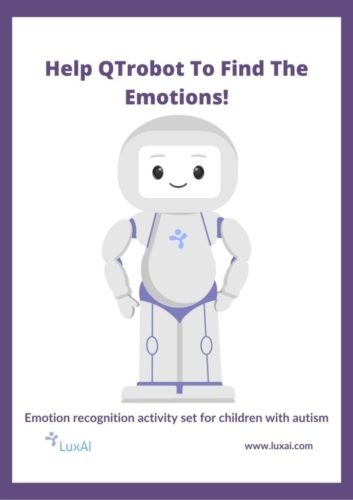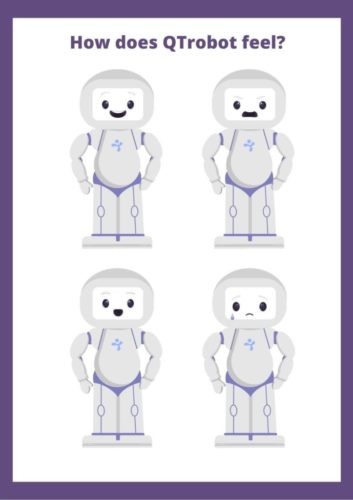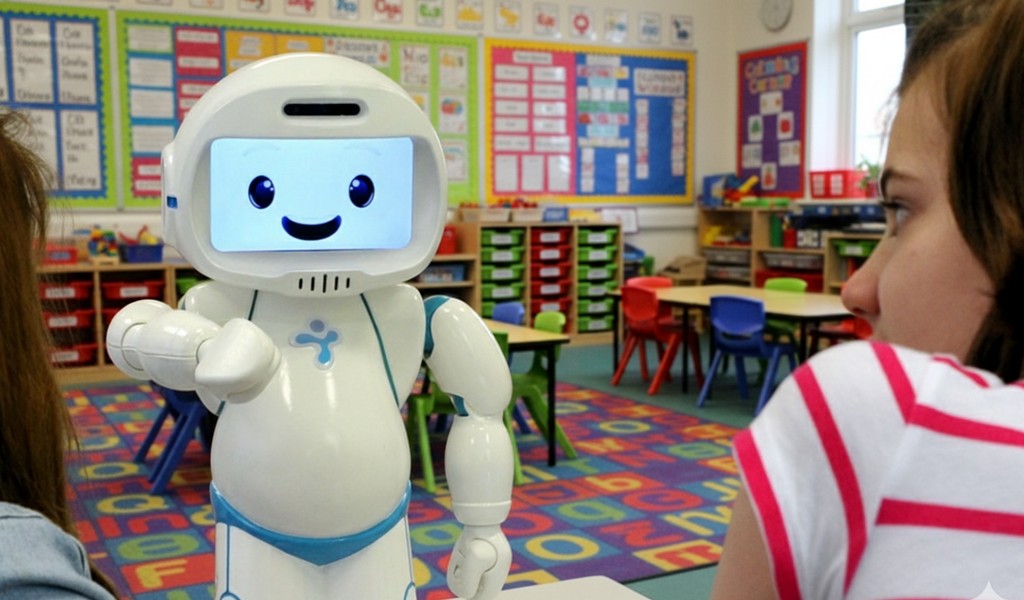Recognizing facial expressions of emotions is critical for creating connections and social interaction in early life. Recognizing emotions and expressions of others is one of the basic skills allowing us to understand people’s intentions and mind status and has an important role in enabling us to interact with people around us. In this blog we share some step by step activities for teaching emotions to children with autism.
Autism and emotions:
Neurotypical children are able to recognize basic facial expressions such as happy and sad from as early as 3 to 4 months of age and they are able to respond to and reciprocate the emotions of others by only 7 months.
One of the main diagnostic characteristics of Autism spectrum disorder (ASD) is difficulty in recognizing and understanding emotions. This includes challenges in identifying facial expressions, body language as well as voice tonality.
Even though autistic children have difficulties to interpret emotions, there many studies showings that children and adults with autism can learn how to recognize and interpret emotions and research has shown that structured activities can positively impact autistic children’s competence in identifying the feelings of others. In this blog, we review 8 useful and practical steps, for teaching emotion recognition and labelling to children with autism.
8 Steps for teaching emotions to children with autism:
Step 1: For teaching emotions choose activities that are age-appropriate for children:
When it comes to teaching any new skill to a child, particularly if they have any neurodevelopmental delays, it is important to choose activities that meet their developmental age. This includes choosing the right stimulus and activity types as well as using the right communication method and vocabulary. For example, if a child is non-verbal or has a limited receptive language repository, it is important to choose a communication method that corresponds to their strengths. While practising a new skill, such as emotion identification, it is best to use simple and straight forward instructions. You can use short and clear sentences and even combine verbal instructions with visual support to make sure children understand the instructions.
Step 2: Focus on one emotion at the time:
This is very tempting to present the child with lots of information and practice materials to learn various emotions. But when it comes to teaching something as complex as emotions, it is critical to take small steps and make sure the child is able to absorb what you are trying to teach them. It is often recommended to start only from basic emotions such as happiness, sadness, anger and fear. Also, we can first start with practising one emotion, for example, happiness, and when the child seems confident in identifying various faces showing a happy emotion, we can add the second feeling.
Step 3: Use visual cards and pictures to teach emotions to children with autism:
Often it is difficult to use dynamic expressions to start teaching emotions to a child with ASD. At first, we can use pictures and visuals with a very specific and often exaggerated expression to help children learn to recognize emotions. It is best to choose pictures that are showing only the face area on a white or blank background. In this way, children can only focus on the components and parts in the face that are creating the expressions.
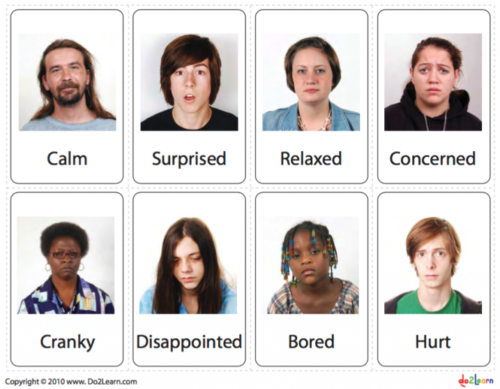
Do2Learn: Educational Resources for Special Needs
Here are some examples of great visual cards and images for practicing emotion recognition:
For very young learners, using smileys and exaggerated cartoon faces can be an effective and age-appropriate start.
Also for many children it is helpful to point out the face parts that signal an emotion. For example, on a picture, we can show the month, eyebrows and eyes, to help the child learn how each of these parts would look like when we express an emotion.
You can also use pictures of specific parts of a face to help children grasp what a happy mouth would look like or how an angry frown is.
Step 4: Make learning emotions fun and engaging!
All children love to play and play-based learning is one of the most effective ways of teaching a new skill in childhood. Try to incorporate emotions in fun activities. There are many activities that trigger curiosity and excitement that can be used to teach emotion recognition and labelling. Below are some examples of activities children love to play and can help them to learn about emotions:
- Mr Potato head
- Transporters video series
- Pantomime play and taking turns in guessing and showing emotions
- Drawing facial expressions and colouring emotions
Below is fun pantomime game that you can play at home to teach emotion recognition, labelling and generation to kids with autism:
Step 5: Use a variety of visuals and activities to help the child generalize their ability to recognize emotions:
The goal of teaching is to help children with autism to gain a skill they can use in their day-to-day natural life. The fact that a child can recognize a set of pictures showing emotions, doesn’t guaranty that they are able to identify a new set of emotions or they can recognize emotions in real life. It is important to allow children to practice emotion recognition in a variety of set ups and across a variety of stimuli. There are a lot of materials that are designed for teaching emotions and you can simply use various image sets or apps to allow kids practice identifying emotions.
Below is a free activity package you can download and use at home to practice emotion recognition with your child:
Step 6: Use visual stories and children’s books to label emotions for kids:
When children are comfortable with recognizing from simple and exaggerated pictures, it’s time to present them with more complex expressions. For example, instead of a picture with a simple expression on a blank background, we can show visuals that are showing the emotions in a real-life scenario. For example, images showing a happy child in a birthday party or an angry child with a broken toy. This will help children to expand their emotion recognition skills, and it will also allow them to gradually put emotions in context and be able to connect emotions with their triggers.
One of the best materials for this step is visual books and stories. When reading a story, you can always label the emotions of the characters and help the child to pay attention to the emotional status of the characters. For example, you can say: “Look the boy is sad, because he lost his favourite toy”! Or “the superhero looks happy because it helped people”.
You can do the same when watching kids’ animations and movies. Whenever appropriate, try to label emotions so your child will be reminded of them.
Step 7: Take teaching emotions outdoors:
When you are out and about with your child, there are numerous opportunities to label emotions and discuss them. For example, when you are in a playground, you can always show a child and label their emotions. This way your child will learn that emotions are always available around us and they can spot them when paying attention to other people around them. Labelling emotions in the natural environment is critical for helping children to generalize their knowledge of emotions and it increases their chance of using their newly acquired skill in their social interaction with others.
Step 8: Ask the child to name emotions:
It is great to start working on emotions with receptive language, meaning a child can identify the emotions after us naming them. This will help to introduce children to emotion vocabulary and build the connection between an emotion word to an emotional status and expression. However, teaching in receptive model, doesn’t always guaranty children to succeed in being able to use emotion words. It is always great to use activities that target expressive language and request children to use their vocabulary. For example, you can show an expression and ask the child to name the expression. Or when you are watching a movie or playing outdoors, ask the child about how they think people are feeling.
Practicing the vocabulary across both receptive and expressive language can increase the chance of generalization and can enhance children’s ability to use the skill in a meaningful way.
Below are some activity worksheets you can download to practice both receptive and expressive language of emotions:
Many young children on the autism spectrum are non-verbal. However, this doesn’t mean that they cannot practice the expressive language. Any communication tool that is used by the child in day-to-day life, can also be used to practice naming emotions. For example, if the child is using an AAC device or PECS, they would be still able to use them to respond to questions like: “How does this child feel?” or “What is the name of this feeling?”
QTrobot educational sessions for emotion recognition and labelling for autism:
QTrobot is a little humanoid robot with an expressive face. By being naturally interesting and engaging as well as being simple and predictable, QTrobot can facilitate teaching social skills such as emotional abilities to children with autism.
In a scientific study focused on emotional ability training, after 7 sessions of interaction with QTrobot and practicing emotional activities, children with autism showed higher emotional skills, including better recognition and emotional appropriateness. Also their mental health was improved by having less internalizing symptoms caused by their emotional difficulties. Read more about the scientific results of using QTrobot for emotional ability training here!
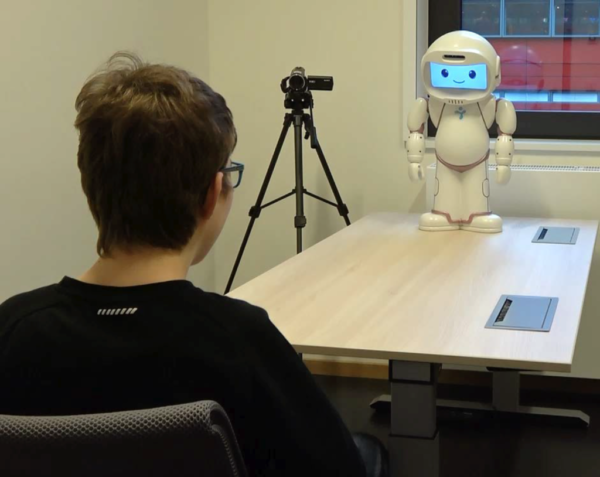
QTrobot comes with a comprehensive educational curriculum focused on emotional skills, allowing children with autism to benefit from structured evidence-based activities, while having fun and playing games.
To teach emotion recognition to children with autism, QTrobot uses leveled activities designed to meet various development levels. Starting from very basic and exaggerated expressions such as smileys and it’s own faces, QTrobot then continues with working toward identification of emotions from real child expressions and video modeling of the emotions. Also, QTrobot incorporates funny activities like playing pantomime game to allow children to practice emotion recognition in a gamified manner.


